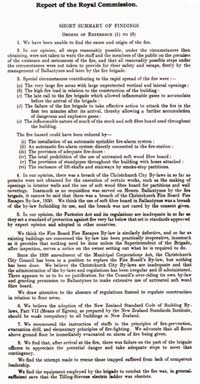SHORT SUMMARY OF FINDINGS
ORDERS OF REFERENCE (1) TO (8)
-
We have been unable to find the cause and origin of the fire.
-
In our opinion, all steps reasonably possible, under the circumstances then obtaining, were not taken to warn the staff and the members of the public on the premises of the existence and seriousness of the fire, and that all reasonably possible steps under the circumstances were not taken to provide for their safety and escape, firstly by the management of Ballantynes and later by the fire brigade.
- Special circumstances contributing to the rapid spread of the fire were:-
- The very large fire areas with large unprotected vertical and lateral openings:
- The high fire load in relation to the construction of the building:
- The late call to the fire brigade which allowed inflammable gases to accumulate before the arrival of the brigade:
- The failure of the fire brigade to take effective action to attack the fire in the first ten minutes after its arrival, thereby allowing a further accumulation of dangerous and explosive gases:
- The inflammable nature of much of the stock and soft fibre board used throughout the building.
- The installation of an automatic sprinkler fire-alarm system:
- An automatic fire-alarm system directly connected to the fire-station:
- The provision of adequate fire-doors:
- The total prohibition of the use of untreated soft wood fibre board:
- The provision of standpipes throughout the building with hoses attached:
- The enclosure of lift-shafts and stairways by smoke-stop partitions.
-
In our opinion, there was a breach of the Christchurch City By-laws in so far as permits were not obtained for the execution of certain works, such as the making of openings in interior walls and the use of soft wood fibre board for partitions and wall coverings. Inasmuch as no requisition was served on Messrs. Ballantynes bv the fire brigade, it cannot be said that there was a breach of the Christchurch Fire Board Fire Escapes By-law, 1930. We think the use of soft fibre board in Ballantynes was a breach of the by-law forbidding its use, and the breach was not cured by the consent given.
-
In our opinion, the Factories Act and its regulations are inadequate in so far as they set a standard of protection against fire very far be low that set in standards approved by expert opinion and adopted in other countries.
We think the Fire Board Fire Escapes By-law is similarly defective, and so far as existing buildings are concerned the by-law has been practically inoperative, inasmuch as it provides that nothing need be done unless the Superintendent of the Brigade, after inspection, serves a notice on the owner setting out what he is required to do.
Since the 1938 amendment of the Municipal Corporations Act, the Christchurch City Council has been in a position to replace the Fire Board's By-law, but nothing has been done. We believe the Christchurch City By-laws are inadequate and that the administration of the by-laws and regulations has been irregular and ill administered. There appears to us to be no justification for the Council's over-riding its own by-law and granting permission to Ballantynes to make extensive use of untreated soft wood fibre board.We draw attention to the absence of regulations framed to regulate construction in relation to floor areas.
-
We believe the adoption of the New Zealand Standard Code of Building Bylaws, Part VII (Means of Egress), as prepared by the New Zealand Standards Institute. should be made compulsory to all buildings in New Zealand.
-
We recommend the instruction of staffs in the principles of fire-prevention, evacuation drill, and elementary principles of fire-fighting. We advocate that all floors above ground floor be immediately evacuated on alarm of fire being given.
-
We find that, after arrival at the fire, there was failure on the part of the brigade officers to appreciate the potential danger and take adequate steps to meet that contingency.
We find the attempt made to rescue those trapped suffered from lack of competent leadership.
We find the equipment employed by the brigade to combat the fire was, in general, sufficient save that the Tilling-Stevens electric ladder was obsolete.
Source
Report of the Royal Commission, New Zealand Parliament. Appendices to the Journals of the House of Representives, 1948. vol.V, H-47. p.30-31.


 Discover your family’s history at our libraries
Discover your family’s history at our libraries

